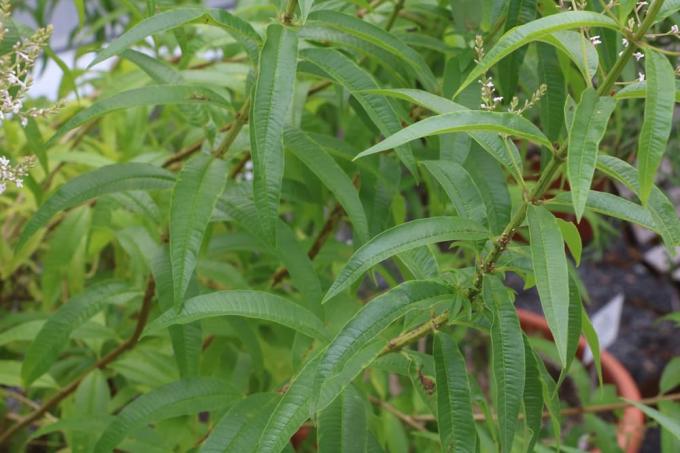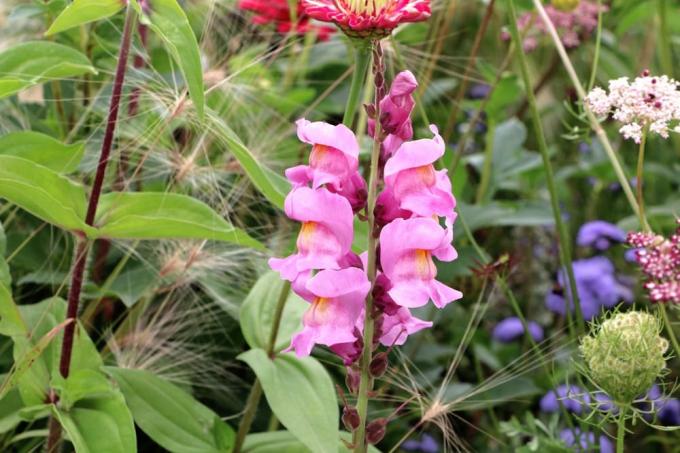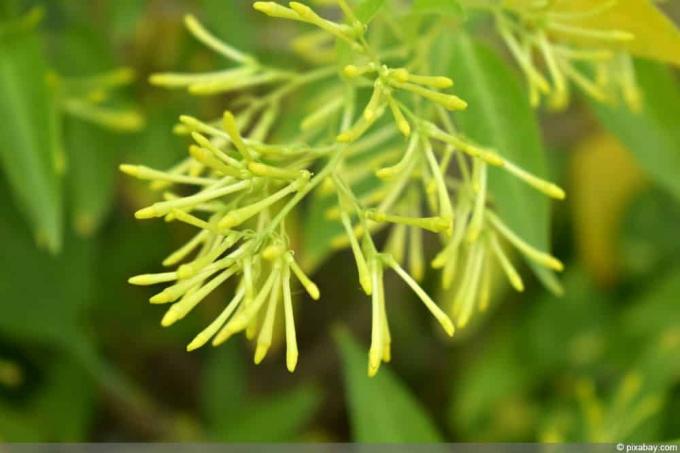

Table of contents
- When does it get uncomfortable?
- Winter is coming, what to do?
- Acceptable winter quarters
- Lemon bush must leave the bed
- Cutting is announced before the move
- The water thirst is modest
- No growth, no nutritional needs
- The leaves say goodbye
- The sun is calling again
- Spring pruning for healthy growth
- Outside only if necessary
Even the name lemon verbena melts on the tongue. There must be a very special plant hiding behind it. And indeed, the South American lemon bush is unique in the local herbal landscape. The intense citrus scent is its greatest asset. A small touch is enough and it flows towards us. How can the herb get through the European winter healthy despite a strong aversion to frost?
When does it get uncomfortable?
The lemon verbena, bot. Aloysia citrodora is of Chilean origin. In its homeland and in the neighboring countries, it greens areas with a mild climate. The weather didn't fare so well for us. In addition, their adaptability quickly reaches insurmountable limits. It gets uncomfortable for her below 10 degrees Celsius, but she bravely perseveres. But from minus degrees below - 4 degrees Celsius it is no longer bearable for them outside. Winter hardiness is and will remain a foreign word in this country, even after years of cultivation.
Winter is coming, what to do?
Due to the lack of winter hardiness, the verbena is usually assigned a mobile dwelling from the outset. Pots can be brought outside quickly and just as quickly into winter quarters. However, some specimens grow directly in the herb bed, where they can reach a considerable size. When the footsteps of winter can already be heard, the gardener's attention is required. You have to choose the right time to move. A fixed calendar date is not necessary. The lemon bush can still take the last rays of sunshine with it. As long as it stays above 12 degrees Celsius, he can stay outside. The plant survives unexpected, light frosty nights unscathed, but should then move indoors at the latest.
Acceptable winter quarters
Green plants thrive on light and therefore belong outdoors. A closed room is always the second choice. But many plants from distant countries are not made for our climate. However, since nobody wants to do without them, winter quarters regularly function as an extension of the garden. For the verbs, it must have the correct key data:
- The room temperature must not fall below – 2 degrees Celsius
- temperatures between 10 and 16 degrees Celsius are ideal
- the room should be dark
- the colder, the darker
- never expose to direct sunlight
- high humidity is beneficial
A notice:
In very dark quarters, the verbena quickly sheds its foliage on the ground. This is no cause for concern. The "naked" stems are covered with new leaves by May of the following year at the latest.
Lemon bush must leave the bed

A lemon bush that has been planted out over the summer does not get an extension of fresh air in late autumn. Instead, he has to pull in his roots and hop into a bucket. The bucket is a must, because overwintering only with bare roots is not good for the shrub. They must always be surrounded by a protective layer of earth. The further procedure is the same as for pure bucket cultures.
Cutting is announced before the move
Old pot dwellers and new pot dwellers alike must leave some of their shoots outside before moving into the winter rooms.
- grab the scissors before the frost
- without exception shorten all shoots
- at least three quarters of the length must go
After the cut, the pots are put in their place, which will serve as their new home for the next few months. If the room is large enough, the individual plants should not touch each other.
The water thirst is modest
The plant mass has decreased significantly after the cut and with it the evaporation surface. The water-consuming growth has also come to a complete standstill. All this has an influence on the winter water balance of the verbena.
- just water every now and then
- the soil should never dry out completely
- only increase the watering in the spring
A notice:
Use stagnant water for watering. It must be neither too cold nor too warm. Ideally it is at room temperature.
No growth, no nutritional needs
Fertilizer is completely unnecessary in winter, since verbena does not require any nutrients. The last nutrient supply should not be later than August anyway. Fertilization should only start again at the beginning of the new vegetation phase.
- from September up to and including March there is a break in growth
- then don't fertilize at all
You can wait with fertilizing until you move outside. A small amount of fertilizer shortly before the end of the wintering phase is also conceivable.
The leaves say goodbye
Verbena almost always sheds its leaves due to lack of light. Sometimes already outside, but mostly only in their winter quarters. Collect the fallen leaves in good time, as they encourage the spread of rot.
Tip:
Fallen leaves belong in the household waste. However, if you have collected and dried fresh leaves in summer, you can now warm up with a delicious verbena tea.
The sun is calling again

Space is scarce in most winter quarters. The pots are close together. This cramped dwelling should be vacated as soon as possible. Even the first warm days of the year are tempting for verbena. But the trip to the fresh air should not be rushed. The weather is not stable, there may still be many frosty nights ahead.
- Verbena is allowed out when the temperature climbs above 12 degrees
- only put them outside during the day until mid-May
- get used to the sun slowly
- pour some more
- start fertilizing in April
Spring pruning for healthy growth
The winter quarters offer reliable protection from the bitter cold and icy winds. But very few plants come out of the hibernation period in one piece. The deprivations have visibly tugged at plant health.
- some shoots do not survive the winter
- grab the scissors again
- remove dried and damaged shoots
- healthy shoots soon follow
Outside only if necessary
It is said to have actually happened that individual plants survived the winter outdoors in our latitudes. This is good news for everyone who loves lemon trees and cannot offer them suitable quarters. The more basic conditions are right, the greater their chances of survival.
- Verbena starts the cold season healthy and strong
- hopefully the winter will be mild
- their location should be sheltered
- Prune verbena vigorously in autumn
- a high covering of foliage gives it warmth
Only in spring will it become clear whether the verbena can spread its citrus scent again.
 Home editorial office
Home editorial office
Learn more about plant overwintering

Is the triplet flower hardy? 10 tips for wintering
The enchanting bougainvillea got its botanical name after its discoverer, the navigator Louis de Bougainville. On the Mediterranean Sea, it embellishes house facades. In Germany, where it is also known as a triplet, it is particularly popular as a container plant. How is it overwintered?

Overwintering poinsettia | Is he hardy?
The poinsettia belongs to the winter season like no other plant. But is it also a plant that is hardy or does it have special requirements when it comes to overwintering? The answers can be found at Hausgarten.net.

Is the snapdragon hardy? | 7 tips for overwintering snapdragons
The snapdragon is considered a classic among the ornamental flowers of the domestic plant bed. It blooms happily and handsomely over many Mondays. But is the snapdragon also hardy and how does the perennial overwinter? You will find the answer to these questions with us.

Ranunculus hibernate: this is how it works | Are ranunculus hardy?
Ranunculus is a beautiful flower, but it is only partially hardy in the local latitudes. Therefore, outdoors, the plant is dependent on warm protection in order to survive low frost temperatures without damage. Alternatively, you can overwinter the tubers in a frost-free place.

Night jasmine, Cestrum nocturnum - care and wintering
The night jasmine has developed into a popular container plant in this country. One reason for this is certainly its beautiful trumpet flowers, which unfold like a star. In order for this to work, however, it depends on the right location and care. More about this is here.

Is the Japanese maple hardy? This is how you overwinter it properly
The Japanese maple is so popular in the local latitudes because it can be cultivated in the garden and in a bucket. Because the tree has its origin in the Japanese mountain regions, where there is a similar climate. It is therefore not difficult to get the plant through the winter well.
